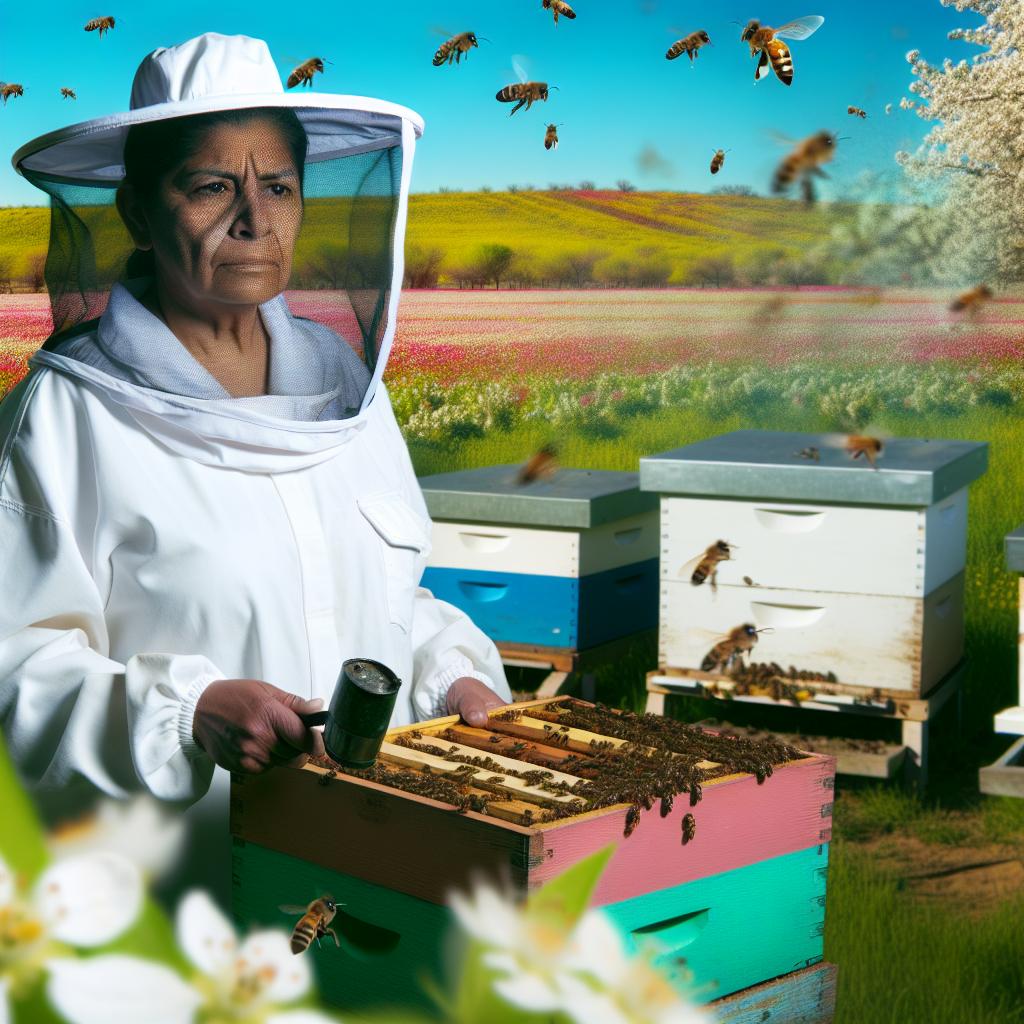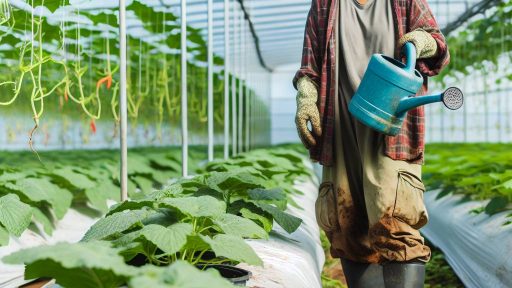Introduction to Beekeeping in the USA
Beekeeping has a long and rich history in the United States.
It dates back to the early colonial days when settlers first brought honeybees.
Today, beekeeping is both a hobby and a commercial enterprise.
In fact, thousands of beekeepers manage hives across the country.
This practice plays a vital role in agriculture by pollinating crops.
Moreover, honey production is an important industry in the U.S.
Despite its benefits, beekeeping also presents significant challenges.
Understanding these challenges prepares beekeepers for success.
New beekeepers often face a steep learning curve.
However, experienced beekeepers can provide valuable insights.
This community support fosters a shared knowledge base.
Additionally, various organizations offer resources and training programs.
Local clubs and associations connect beekeepers with a network of support.
Thus, beekeeping enthusiasts can learn from each other’s experiences.
Furthermore, beekeeping can positively impact the environment.
Transform Your Agribusiness
Unlock your farm's potential with expert advice tailored to your needs. Get actionable steps that drive real results.
Get StartedBy maintaining bee populations, enthusiasts contribute to ecosystem health.
With dedication and education, beekeepers can thrive.
Overview of Common Beekeeping Challenges
Beekeeping presents several unique challenges for enthusiasts and commercial apiarists alike.
Understanding these challenges is essential for successful beekeeping.
This guide explores common issues faced by beekeepers in the United States.
Pest Management
Pests pose a significant threat to bee colonies.
Varroa mites are among the most troublesome pests.
These mites weaken bees and can lead to colony collapse.
Regular inspections can help monitor pest levels.
Treatments include chemical and natural options.
Climate Impacts
Climate change affects bee populations and flowering plants.
Extreme weather patterns disrupt foraging patterns.
Additionally, rising temperatures may impact hive health.
Beekeepers should stay informed about local climate conditions.
Adaptive strategies can mitigate these effects.
Bee Diseases
Various diseases threaten bee health and productivity.
American foulbrood is a highly contagious bacterial infection.
Nosema is another common disease that affects the gut.
Symptoms can include reduced hive activities and increased mortality.
Regular health checks will help early detection and management.
Floral Availability
Bees need diverse food sources to thrive.
Without access to sufficient flora, they cannot collect nectar and pollen.
Urbanization and agriculture can limit floral availability.
Planting bee-friendly flowers can support local populations.
Showcase Your Farming Business
Publish your professional farming services profile on our blog for a one-time fee of $200 and reach a dedicated audience of farmers and agribusiness owners.
Publish Your ProfileBeekeepers should assess local floral resources regularly.
Regulatory Challenges
Beekeeping regulations vary significantly across state lines.
Some states require permits and registration.
Staying compliant is crucial for all beekeepers.
Local beekeeper associations often provide guidance.
Networking can also help navigate these complexities.
Colony Collapse Disorder
Overview of Colony Collapse Disorder
Colony Collapse Disorder (CCD) poses serious threats to beekeeping in the USA.
This phenomenon involves the sudden disappearance of worker bees from a hive.
It significantly impacts honey production and pollination services.
Understanding its causes can help beekeepers take preventive measures.
Causes of Colony Collapse Disorder
Several factors contribute to Colony Collapse Disorder.
- Pesticide exposure leads to harmful effects on bee health.
- Pathogens and parasites weaken colonies, making them vulnerable.
- Environmental changes disrupt the bees’ natural habitat.
- Genetic factors may limit the resilience of bee populations.
Signs of Colony Collapse Disorder
Beekeepers should monitor their hives for signs of CCD.
Sudden drops in bee population indicate potential issues.
Additionally, the presence of empty hives and no dead bees is alarming.
Dead queens may also be observed within the hive.
Strategies to Combat Colony Collapse Disorder
Taking proactive measures can significantly reduce the risk of CCD.
- Implement integrated pest management practices to control mites.
- Minimize pesticide use, especially during blooming seasons.
- Provide a diverse foraging environment to enhance bee health.
- Regularly inspect hives for early signs of health issues.
Resources for Beekeepers
By understanding CCD, beekeepers can protect their colonies effectively.
Accessing resources from local agricultural extensions can provide valuable insights.
Participating in community workshops also enhances knowledge on bee management.
Discover More: How to Use Companion Planting for Weed Suppression
Solutions for Colony Collapse Disorder
Understanding Colony Collapse Disorder
Colony Collapse Disorder (CCD) dramatically impacts beekeeping.
It leads to the unexplained loss of bee colonies nationwide.
Understanding its causes is crucial for effective management.
Identifying the Causes
Several factors contribute to CCD, including pesticides.
Pesticides like neonicotinoids harm honeybee health.
In addition, pathogens and parasites weaken bee colonies.
Nosema and Varroa mites significantly threaten hive stability.
Implementing Effective Management Strategies
Beekeepers should employ integrated pest management (IPM).
IPM focuses on minimizing pesticide use effectively.
Monitoring hives regularly helps identify stressors early.
Furthermore, maintain healthy environments around hives.
Choosing Resistant Bee Strains
Selecting breeds that show resistance to CCD can enhance resilience.
Varieties like Russian or Carniolan bees exhibit hardiness.
These bees adapt well to stressful conditions.
Enhancing Foraging Efficiency
Providing diverse foraging options improves bee health.
Planting varied flowers encourages balanced diets for bees.
Incorporating native plants creates attractive habitats.
Collaborating with Other Beekeepers
Networking with fellow beekeepers strengthens community knowledge.
Sharing experiences provides valuable insights into best practices.
Additionally, participating in local beekeeping associations fosters support.
Showcase Your Farming Business
Publish your professional farming services profile on our blog for a one-time fee of $200 and reach a dedicated audience of farmers and agribusiness owners.
Publish Your ProfileStaying Informed and Educated
Continuous education is vital for modern beekeeping.
Attending workshops and seminars exposes beekeepers to new research.
Moreover, reading scientific journals keeps beekeepers updated on CCD.
Advocating for Policy Changes
Beekeepers can lobby for regulations protecting bee populations.
Supporting bans on harmful pesticides plays a significant role.
Furthermore, advocating for research funding enhances future solutions.
Discover More: Permaculture Water Management Strategies for Farms
Pests and Parasites
Understanding Varroa Mites
Varroa mites pose a significant threat to beekeeping.
These tiny parasites attach to bees and feed on their bodily fluids.
As a result, they weaken the bees and spread diseases.
Consequently, managing these pests is crucial for hive health.
Identifying Varroa Infestation
Recognizing an infestation early is essential for survival.
Look for signs of adult mites on bees or in hives.
Additionally, observe any unusual bee behavior or increased mortality.
Regular inspections help catch infestations before they escalate.
Control Methods for Varroa Mites
Several effective control methods exist for managing varroa mites.
Consider chemical treatments such as miticides.
These compounds specifically target varroa mites without harming bees.
Alternatively, natural treatments using essential oils may also work.
Shaking bees or drone brood removal can reduce mite populations effectively.
Monitoring and Maintenance
Regular monitoring is vital for continued success.
Install sticky boards to measure mite levels over time.
Track changes and adjust your management practices accordingly.
By staying vigilant, you can maintain healthy hives for your bees.
Preventative Measures
Preventing varroa infestations can save you time and resources.
Start by maintaining strong, healthy colonies.
Healthy bees can better resist mite pressures.
Diversify your apiary by adding more colonies and genetic diversity.
Finally, ensure that your beekeeping equipment is clean and disinfected.
Find Out More: Enhancing Biodiversity With Native Plants For Sustainable US Landscapes
Effective Pest Management Strategies
Understanding Common Pests
Beekeepers in the USA face various pest challenges.
Some common pests include the Varroa mite, wax moths, and small hive beetles.
Identifying these pests early can prevent significant hive damage.
For instance, the Varroa mite can devastate a colony if not managed promptly.
Integrated Pest Management Techniques
Integrated Pest Management (IPM) offers a comprehensive approach.
This strategy combines biological, physical, and chemical methods.
First, monitor pest levels regularly using traps and visual inspections.
Then, employ natural predators to keep pest populations in check.
For example, introducing beneficial insects can mitigate wax moths.
Additionally, use chemical treatments as a last resort.
Showcase Your Farming Business
Publish your professional farming services profile on our blog for a one-time fee of $200 and reach a dedicated audience of farmers and agribusiness owners.
Publish Your ProfileMaintain Hive Health
Healthy hives are less susceptible to pests.
Ensure your bees have a balanced diet containing nectar and pollen.
Provide adequate ventilation to reduce moisture levels within the hive.
Regular hive inspections can detect early signs of pests or disease.
Utilizing Technology
Modern technology can enhance pest management efforts.
Smart sensors can monitor hive conditions and alert you to changes.
Mobile apps can assist in tracking pest management strategies and outcomes.
Using data from these tools allows you to make informed decisions.
Community Collaboration
Engaging with local beekeeping clubs can provide support.
These groups often share pest management experiences and solutions.
Collaborating with other beekeepers creates a network of knowledge.
A collective effort can significantly reduce pest populations in the area.
Learn More: Using Pollinator Habitats To Boost Crop Yields In American Small-Scale Farms
Environmental Factors
Impact of Weather
Weather plays a vital role in beekeeping success.
Temperature extremes can hinder bee activity.
Moreover, excessive rain can disrupt foraging.
It’s important to monitor local weather patterns.
Keeping track of temperature and humidity helps.
Beekeepers should adjust management practices accordingly.
Adapting to Seasonal Changes
Seasons influence nectar availability significantly.
Spring blooms often determine honey production potential.
Thus, beekeepers must plan for seasonal variations.
Storing adequate food for winter is crucial.
This ensures colonies survive harsh conditions.
Effects of Habitat Loss
Habitat loss presents a significant threat to bees.
Urbanization and agriculture reduce available forage.
As a result, bees face challenges in finding food.
Planting diverse flowers can enhance local environments.
Additionally, creating bee-friendly gardens boosts their chances.
Combating Environmental Challenges
Beekeepers can take proactive steps to mitigate challenges.
First, maintaining healthy colonies is essential.
Regular checks for diseases and pests improve resilience.
Moreover, beekeepers can join local conservation efforts.
This helps advocate for better habitats and policies.
Collaboration with local farmers can also benefit bees.
Promoting organic practices improves overall ecosystem health.
Adapting Beekeeping Practices to Climate Change
Understanding Climate Variability
Beekeepers must grasp the effects of climate change on bee populations.
Higher temperatures and unpredictable weather patterns impact bee behavior.
Furthermore, changes in flower availability alter foraging patterns.
Addressing these challenges requires knowledge and flexibility.
Showcase Your Farming Business
Publish your professional farming services profile on our blog for a one-time fee of $200 and reach a dedicated audience of farmers and agribusiness owners.
Publish Your ProfileImplementing Seasonal Adjustments
Adjusting hive management according to seasonal changes is crucial.
For instance, earlier spring warm-ups may lead to earlier brood rearing.
Consequently, beekeepers should inspect hives sooner in the year.
Additionally, monitoring nectar flows can help manage resource allocation.
Enhancing Hive Resilience
Improving hive resilience helps mitigate climate-related stressors.
One effective method involves selecting climate-hardy bee strains.
For example, Italian and Carniolan bees often adapt well to varied conditions.
Moreover, maintaining hive health through regular inspections is vital.
Managing Water Resources
Water availability affects bee health and productivity significantly.
During dry spells, ensure bees have access to clean water sources.
Setting up water stations around hives can support local bees.
Also, minimize competition from other wildlife for these resources.
Using Climate-Smart Beekeeping Techniques
Employing innovative techniques can improve outcomes for beekeepers.
Implementing shaded areas around hives can help regulate temperatures.
Additionally, utilizing insulated hive boxes can protect against extreme weather.
Taking these steps fosters a healthier environment for bees.
Engaging with Research and Community
Beekeepers should actively seek out current research on climate impact.
Joining local bee clubs promotes knowledge sharing and support.
Participating in workshops enhances skills for adapting to climate change.
Lastly, collaboration fosters resilience within the beekeeping community.
Diseases Affecting Bees
Understanding Nosema
Nosema is a common disease impacting honey bees in the USA.
This fungal infection affects the digestive system of bees.
It can lead to decreased honey production and increased mortality.
Symptoms often include dysentery, poor foraging behavior, and reduced colony strength.
Signs of Infection
Beekeepers should be vigilant for signs of Nosema.
- Look for bees with abnormal feces around the hive entrance.
- Monitor for unusual foraging patterns.
- Check colonies for dwindling populations.
Preventive Measures
Preventing Nosema begins with maintaining colony health.
Ensure bees have access to clean water and healthy forage.
Additionally, keep hives in a dry and well-ventilated area.
Regularly inspect and manage hive populations to reduce stress.
Treatment Options
If Nosema is detected, treatments are available for beekeepers.
Antibiotics like Fumagillin can help control the infection.
Moreover, implementing good management practices is crucial.
Ensure proper feeding and hive sanitation to bolster bee immunity.
Other Common Diseases
Beekeepers should also be aware of other diseases.
- American Foulbrood affects bee larvae.
- Varroa mites pose significant threats to colonies.
- Chalkbrood can weaken hives through fungal infection.
Monitoring for these diseases is essential for hive health.

Preventive Measures and Treatment Options for Bee Diseases
Understanding Common Bee Diseases
Beekeepers face various challenges, primarily due to bee diseases.
Common diseases include Varroa mites, American foulbrood, and Nosema.
Recognizing these conditions early improves the chances of successful management.
Preventive Measures
Implementing preventive measures is crucial in beekeeping.
Regular hive inspections help identify signs of disease early.
Showcase Your Farming Business
Publish your professional farming services profile on our blog for a one-time fee of $200 and reach a dedicated audience of farmers and agribusiness owners.
Publish Your ProfileUsing strong and healthy stock reduces susceptibility to infections.
Additionally, maintaining good hive hygiene is vital for disease prevention.
Ensure equipment is clean and disease-free before introducing new colonies.
Using Integrated Pest Management
Integrated Pest Management (IPM) combines multiple strategies for effective disease management.
This approach includes monitoring, biological controls, and chemical interventions.
By using IPM, beekeepers can minimize pesticide exposure.
Furthermore, incorporating beneficial insects adds a natural defense against pests.
Treatment Options for Bee Diseases
When disease strikes, timely treatment is essential to protect the colony.
For Varroa mites, various chemical treatments are available.
Oxalic acid and formic acid are popular choices among beekeepers.
American foulbrood requires immediate action, often involving the destruction of infected colonies.
Nosema can be treated with medications like fumagillin.
Collaboration and Education
Engaging with local beekeeping associations enhances knowledge and support.
Participating in workshops aids in learning new techniques and treatments.
Sharing experiences with fellow beekeepers fosters community resilience.
Always stay informed about the latest research and advancements in bee health.
Lack of Forage and Nutrition
Understanding the Importance of Forage
For bees, forage is essential for their survival.
It provides the nectar and pollen they need to thrive.
Moreover, a lack of forage leads to malnutrition in bee colonies.
This problem arises from urbanization and agricultural practices.
Beekeepers must recognize the significance of forage quality.
Identifying Forage Shortages
Beekeepers should regularly assess local forage availability.
Changes in land use can significantly reduce forage options.
For example, the removal of wildflowers affects bee nutrition.
Additionally, seasonal fluctuations impact forage availability.
Monitoring floral sources helps identify periods of scarcity.
Enhancing Forage Opportunities
Planting bee-friendly flowers can greatly improve available forage.
Consider adding clover, sunflowers, and wildflowers to gardens.
Participate in local conservation efforts to protect habitats.
Also, nonprofit organizations like the Pollinator Partnership promote these initiatives.
Furthermore, creating forage-rich environments benefits both bees and local ecosystems.
Supplementing Bee Nutrition
Sometimes, forage alone isn’t enough for healthy colonies.
In such cases, beekeepers can provide sugar syrup or pollen patties.
These supplements support bees during forage shortages.
Be aware, however, of the proper ratios and feeding techniques.
Incorporating these practices can help colonies thrive during tough times.
Creating a Sustainable Forage Plan
Developing a sustainable forage plan is crucial for beekeepers.
This plan should include a mix of perennial and annual plants.
Regularly revisiting and updating the plan ensures it remains effective.
Networking with local farmers can also enhance forage availability.
Showcase Your Farming Business
Publish your professional farming services profile on our blog for a one-time fee of $200 and reach a dedicated audience of farmers and agribusiness owners.
Publish Your ProfileCollaborative efforts yield better results for honeybee health.
Strategies for Improving Bee Nutrition and Foraging
Understanding Bee Nutrition
Nutrition plays a crucial role in bee health and productivity.
Bees require a balanced diet rich in proteins, carbohydrates, and vitamins.
Adequate nutrition supports their immune systems and overall vitality.
Identifying Nutritional Needs
Assess the nutritional needs of your bee population regularly.
Consider the life stages of the bees, as they have different requirements.
Moreover, monitor their foraging habits to determine food availability.
Enhancing Foraging Opportunities
Create a diverse landscape to promote foraging.
Planting a variety of flowering plants increases nectar sources.
Utilize native plants, as they tend to attract local pollinators.
Incorporate plants that bloom at different times to ensure year-round food.
Using Supplemental Feeding
Supplying supplemental feeding can be beneficial during dearth periods.
Provide sugar syrup as a short-term energy source.
Pollen patties can help meet protein needs in early spring.
Monitoring Environmental Changes
Stay informed about environmental changes affecting bee foraging.
Climate change can impact flowering times and food availability.
Adapt your beekeeping practices to address these challenges.
Establishing Community Gardens
Encourage local community gardens to support bee-friendly habitats.
Community involvement can increase available food sources for bees.
Moreover, these gardens can provide educational opportunities for the public.
Collaboration with Local Farmers
Work with local farmers to create pollinator-friendly farming practices.
Encourage the use of cover crops that provide forage for bees.
Engaging in cooperative efforts fosters a healthier ecosystem for bees.
Regulatory and Legal Issues in Beekeeping
Understanding Local Laws
Beekeepers must understand local laws regarding beekeeping.
Regulations can vary significantly from one area to another.
Some cities prohibit beekeeping outright or require permits.
Research applicable local ordinances to remain compliant.
Engaging with local beekeeping associations can provide clarity.
State Regulations and Licensing
Each state in the USA has its own rules regarding beekeeping.
Some states require beekeepers to register their hives.
Licensing helps to track bee populations for health and safety.
Check your state’s agricultural department for specific requirements.
Pest Management Regulations
Regulations often govern the use of pesticides around beehives.
Local laws may restrict specific chemicals harmful to bees.
Understanding these restrictions helps protect your bees and the environment.
Utilize integrated pest management (IPM) practices to comply.
Insurance and Liability
Beekeepers should consider liability insurance for potential damages.
In some areas, it may be required to carry insurance.
Insurance protects against claims related to bee stings or property damage.
Consult local insurance providers to explore options.
Showcase Your Farming Business
Publish your professional farming services profile on our blog for a one-time fee of $200 and reach a dedicated audience of farmers and agribusiness owners.
Publish Your ProfileKeeping Up with Changes
Regulatory frameworks can change frequently.
Stay informed about local and state legislation affecting beekeeping.
Attend local beekeeping meetings and conferences.
Joining beekeeping associations can provide valuable resources.
Advocacy and Representation
Advocacy plays a crucial role in beekeeping regulations.
Beekeepers can join forces to influence policies at various levels.
Collaborating enhances the voice of beekeepers in local government.
Active participation often leads to more favorable regulations.
Navigating Local and Federal Beekeeping Regulations
Understanding Local Regulations
Local regulations impact beekeeping significantly.
Each city or county may have different rules.
Check with local government offices for specific guidelines.
Engaging with local beekeeping associations can also help.
They often have resources and advice on navigating laws.
Staying Informed About Federal Laws
Federal regulations govern aspects of pollinator health.
They include guidelines for pesticide usage and bee transportation.
Be aware of the Animal and Plant Health Inspection Service (APHIS) regulations.
Regularly check their website for updates on federal policies.
Obtaining Required Permits
Some states require permits for beekeeping operations.
Contact your state’s agricultural department for specific requirements.
Permits often ensure hive health and safety for neighboring communities.
Complete any necessary applications promptly to avoid fines.
Participating in Educational Workshops
Attend workshops to learn about compliance with laws.
These events enhance your understanding of best practices.
Local extension services or beekeeping clubs usually host them.
Networking with experienced beekeepers can provide valuable insights.
Building Relationships with Local Authorities
Establishing communication with local officials is beneficial.
They can clarify doubts regarding regulations you may have.
Being proactive can foster a positive relationship with the community.
This approach helps in case of any future issues or changes.
Utilizing Online Resources
The internet offers vast resources for regulatory information.
Websites like the USDA provide updates on federal regulations.
Search for local beekeeping groups and forums for additional guidance.
Utilize social media to connect and learn from fellow beekeepers.
Documenting Compliance Efforts
Keep records of your compliance with regulations.
Documenting hive management practices aids in audits.
This practice helps maintain standard operating procedures.
It also serves as a reference for future inspections.
Sustainable Solutions for Future Beekeeping
Innovative Practices
Adopting innovative practices can revitalize beekeeping in the USA.
For instance, utilizing integrated pest management helps control pests naturally.
This strategy reduces the need for chemical treatments.
Showcase Your Farming Business
Publish your professional farming services profile on our blog for a one-time fee of $200 and reach a dedicated audience of farmers and agribusiness owners.
Publish Your ProfileAdditionally, urban beekeeping has gained popularity, maximizing limited spaces.
Urban environments can provide diverse foraging opportunities for bees.
Education and Community Engagement
Education plays a crucial role in sustainable beekeeping practices.
Local beekeeping associations often offer workshops and training sessions.
These resources help beekeepers stay informed about best practices.
Moreover, community engagement can foster support for local beekeeping.
By organizing events, beekeepers can raise awareness about pollinator health.
Environmental Stewardship
Practicing environmental stewardship benefits both bees and ecosystems.
Planting pollinator-friendly gardens supports bee populations.
Native plants can provide vital resources for foraging bees.
For example, flowering shrubs and wildflowers invite bees to thrive.
Furthermore, reducing pesticide use enhances local biodiversity.
Research and Development
Investing in research and development is essential for beekeeping’s future.
Collaborations between farmers and scientists yield fruitful results.
For instance, researchers study bee health, improving resistance to diseases.
This knowledge informs beekeepers of effective management techniques.
Moreover, funding can support innovative technologies, like hive monitoring systems.
Long-term Vision for Beekeeping
Establishing a long-term vision guarantees a sustainable future for beekeeping.
Beekeepers must anticipate challenges and adapt practices accordingly.
By focusing on sustainability, they contribute to global food security.
Embracing sustainable solutions creates a better environment for bees.
Ultimately, the survival of beekeeping hinges on collective efforts and commitment.
Additional Resources
How Much Space Does a Beehive Need? Keeping Backyard Bees
Things to consider before starting to house solitary bees : r …




